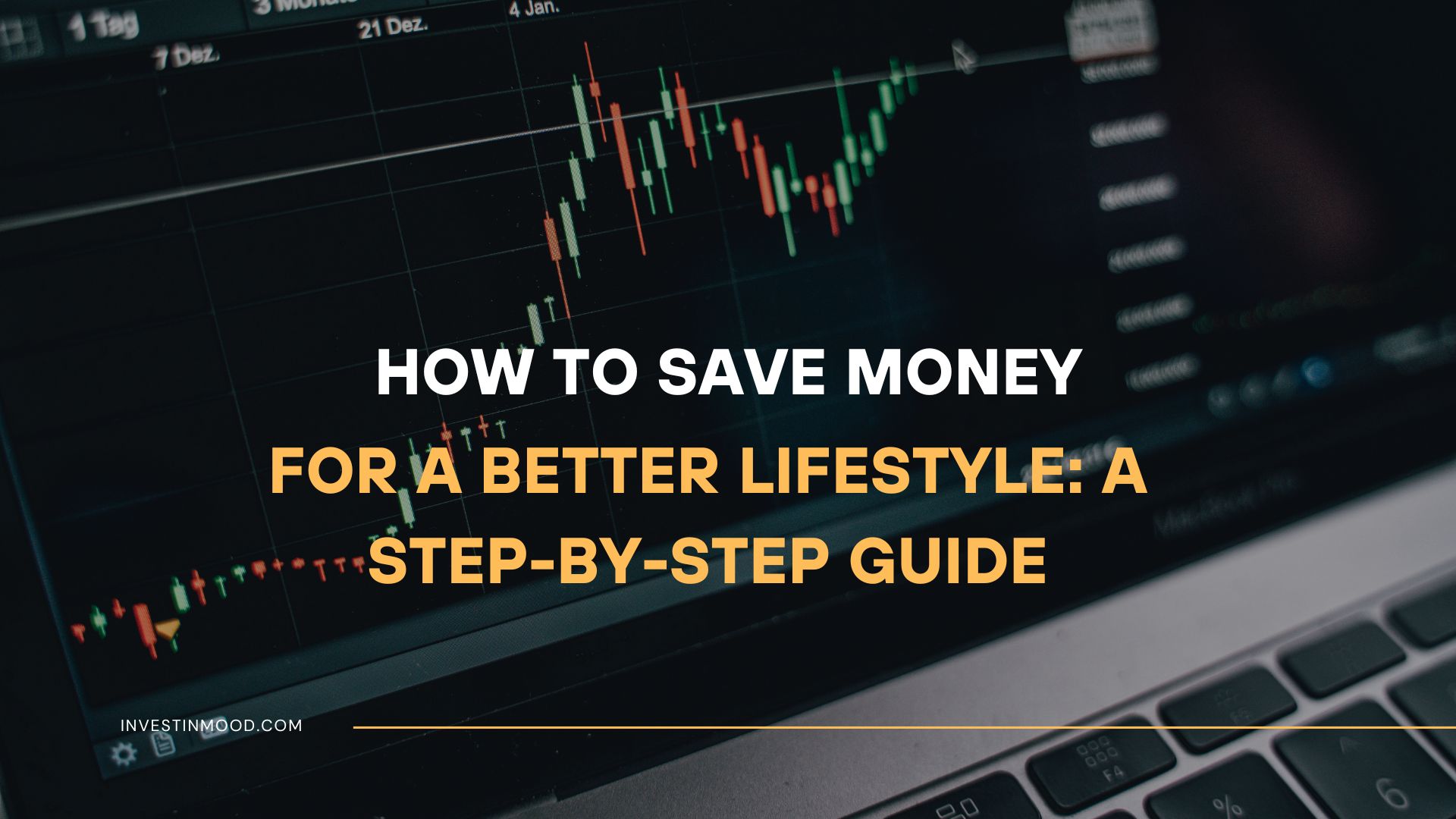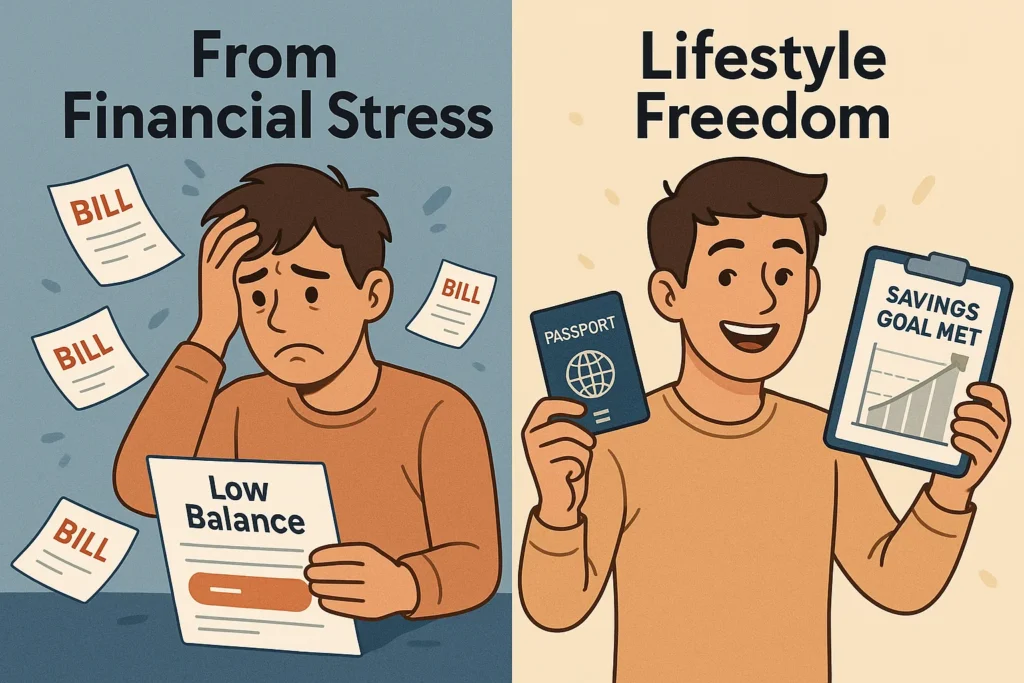
How to Save Money for a Better Lifestyle Step-by-Step Guide
Tired of living paycheck to paycheck and feeling like you can’t get ahead? Learning how to save money effectively is the key to unlocking financial peace and funding the lifestyle you truly desire. This step-by-step guide will walk you through a proven process, from mindset shifts to practical systems, so you can build wealth without feeling deprived.
For individuals in the US, UK, and Canada, implementing these strategies can help you combat inflation, save for major goals like a home down payment, and build a robust emergency fund, all while enjoying your daily life.
Summary Table
| Aspect | Detail |
|---|---|
| Goal | To build sustainable saving habits that fund your ideal lifestyle and provide financial security. |
| Skill Level | Beginner to Intermediate |
| Time Required | Initial setup: 2-3 hours; Ongoing: 30 mins/week |
| Tools Needed | Spreadsheet (Excel/Google Sheets), Banking App, Budgeting Tool (e.g., Mint, YNAB) |
| Key Takeaway | Saving money is not about deprivation; it’s about aligning your spending with your values to create a more fulfilling and secure life. |
Why Learning to Save Money Effectively is Crucial
Saving money is often portrayed as a grim exercise in self-denial. But the truth is, effective saving is the single most powerful tool for designing a life you love. It’s not about what you’re giving up; it’s about what you’re gaining—freedom from stress, the ability to seize opportunities, and the resources to enjoy experiences that matter most to you.
The Problem It Solves: Living with constant financial anxiety, being unable to handle emergencies, and feeling stuck in a job or lifestyle because you lack the funds to make a change.
The Outcome: You will gain control over your finances, reduce daily stress, and build the financial runway needed to invest in your future, take that dream vacation, or simply enjoy peace of mind.
Key Takeaways

What You’ll Need Before You Start
Before diving into the step-by-step process, gather these items to set yourself up for success.
Knowledge Prerequisites: A basic understanding of your monthly income and expenses. You don’t need to be a finance expert, just honest about your cash flow.
Data Requirements:
- 3 months of bank statements and credit card bills.
- A list of all your recurring subscriptions and bills (Netflix, gym, phone, insurance, etc.).
- Your login details for your primary bank account.
Tools & Platforms:
- A Spreadsheet: Google Sheets or Microsoft Excel is perfect.
- A Budgeting App (Optional but helpful): Tools like Mint (for automated tracking) or You Need A Budget (YNAB) (for proactive budgeting) can streamline the process.
- Your Banking App: For setting up automatic transfers.
To get a clear picture of your finances, using a budgeting tool is essential. For beginners, free apps like Mint are a great start, while those wanting a more proactive method often prefer paid services like YNAB. You can compare features on trusted review sites like NerdWallet’s Budgeting App Guide.
How to Save Money for a Better Lifestyle
Step 1: Conduct a Full Financial Audit
Before you can plan where you’re going, you need to know where you are. This step is about uncovering the truth about your spending habits.
- Action: Gather your last 3 months of bank and credit card statements. Categorize every single expense into buckets like: Housing, Food (split Groceries and Dining Out), Transportation, Utilities, Subscriptions, Entertainment, Personal Care, etc.
- Tool: Use a spreadsheet or the categorization feature in a budgeting app.
Pro Tip: Don’t judge yourself during this process. Be a detective, not a critic. The goal is to gather data, not to feel guilty.
Step 2: Set “Why-Powered” Financial Goals
Saving money without a purpose is like driving without a destination. Your “why” is your fuel.
- Action: Define 3 types of goals:
- Short-Term (0-12 months): e.g., $1,000 emergency fund, a new laptop, a weekend getaway.
- Mid-Term (1-5 years): e.g., a down payment for a car or home, a wedding.
- Long-Term (5+ years): Retirement, children’s education, financial independence.
- Be Specific: Instead of “save for vacation,” write “Save $2,000 for a trip to Italy in October 2024.”
Common Mistake to Avoid: Setting only long-term goals. Short-term wins provide the motivation to keep going.
Step 3: Design a “Lifestyle-First” Budget
A budget shouldn’t feel like a prison. It’s a plan for your money to ensure it funds the life you want.
- Action: Choose a budgeting framework. The 50/30/20 rule is excellent for beginners:
- 50% of income to Needs (rent, groceries, utilities).
- 30% of income to Wants (dining, hobbies, shopping).
- 20% of income to Savings & Debt Repayment.
- Adjust: Based on your audit from Step 1, adjust these percentages to fit your reality and goals. The key is to ensure the “Savings” category is a non-negotiable line item.
Step 4: Automate Your Savings
Willpower is finite. Automation is forever. This is the most critical step for consistent success.
- Action: Set up an automatic transfer from your checking account to your savings account(s) for the same day you get paid.
- Strategy: This is “Paying Yourself First.” If you never see the money in your spending account, you won’t be tempted to spend it.
Pro Tip: Open separate high-yield savings accounts for different goals (e.g., “Emergency Fund,” “Travel,” “Car Fund”). Automate transfers to each.
How to Use Your New Savings System in Your Daily Life
Theory is useless without action. Here’s how to make this system work for you.
Scenario 1: You Get a Windfall (Tax Refund, Bonus, Gift): Follow the 50/30/20 spirit. Put 50% towards debt or long-term savings, 30% towards a fun want (like a nice dinner), and 20% into your emergency fund. This prevents “lifestyle creep” while still allowing you to enjoy the bonus.
Scenario 2: You Face an Unexpected Expense: This is what your emergency fund is for! Pay for the expense from the fund without guilt or stress. Then, focus on rebuilding the fund with your automated savings.
Case Study: “Sarah, a marketing manager, was always broke despite a good salary. After her audit, she found she was spending $250/month on unused subscriptions and impulse food delivery. She canceled the subscriptions, meal-prepped on weekends, and automated a $300/month transfer to a ‘Europe Trip’ fund. Within 10 months, she was sipping coffee in Paris, fully paid for by her new habits.”
Top 10 Saving Money Tips to Enjoy a Better Lifestyle
While the step-by-step framework provides the foundation, these ten actionable tips will accelerate your savings while enhancing your daily life. Each tip is designed to be implemented immediately and deliver tangible results.
1. Implement the 24-Hour Rule for All Non-Essential Purchases
How it works: Before buying anything that isn’t a necessity, wait 24 hours. If you still want it after a day, then consider purchasing it.
Why it works: This simple rule eliminates impulse buys, which account for significant wasted money. You’ll be surprised how many “must-have” items you forget about entirely.
Lifestyle benefit: Reduces buyer’s remorse and clutter, ensuring you only bring items into your life that you truly value.
2. Negotiate Your Recurring Bills Every 6 Months
How it works: Set calendar reminders to call service providers (internet, cable, insurance, phone) twice a year to ask for better rates or competitor offers.
Why it works: Companies often have retention deals they don’t advertise. A 15-minute call can save you hundreds annually.
Lifestyle benefit: More money stays in your pocket without reducing your service quality.
3. Create a “Fun Fund” Within Your Budget
How it works: Allocate a specific amount each month purely for enjoyment—dining out, hobbies, entertainment—with no guilt attached.
Why it works: Prevents budget burnout by making saving sustainable rather than restrictive.
Lifestyle benefit: You enjoy life now while still building for the future, eliminating the deprivation mindset.
4. Practice “Pantry Challenges” Once a Month
How it works: Designate one week per month where you only eat what’s already in your pantry, freezer, and refrigerator.
Why it works: Reduces food waste and grocery bills while encouraging creativity in the kitchen.
Lifestyle benefit: Develops cooking skills, reduces decision fatigue about meals, and clears out kitchen clutter.
5. Use Cash-Back Apps for Essential Purchases
How it works: Install apps like Rakuten, Honey, or Ibotta and use them for purchases you were already planning to make.
Why it works: Essentially gives you a discount on necessary spending without changing your habits.
Lifestyle benefit: The accumulated cash back can fund special treats or boost savings goals.
6. Optimize Your Subscriptions with the “One In, One Out” Rule
How it works: For every new subscription service you add, cancel an existing one.
Why it works: Prevents subscription creep, where monthly fees slowly drain your budget unnoticed.
Lifestyle benefit: Forces conscious evaluation of what services actually bring you value.
7. Master the “No-Spend Weekend” Challenge
How it works: Designate one weekend per month where you spend zero money on entertainment or dining out.
Why it works: Encourages free community events, hobbies you already own, and socializing at home.
Lifestyle benefit: Rediscover local parks, board games, book reading, and other low-cost pleasures.
8. Implement the “30-Day Savings Rule” for Big Purchases
How it works: For any purchase over $100, save for it gradually over 30 days in a separate envelope or account.
Why it works: Eliminates credit card debt for discretionary purchases and ensures you truly value the item.
Lifestyle benefit: The anticipation period often makes the eventual purchase more satisfying.
9. Become a “Social Coordinator” with Friends
How it works: Instead of defaulting to expensive restaurants or bars, suggest potlucks, game nights, or outdoor activities.
Why it works: Socializing becomes more meaningful and significantly cheaper.
Lifestyle benefit: Strengthens relationships through more interactive and memorable experiences.
10. Conduct Quarterly “Financial Fitness” Reviews
How it works: Every three months, review your budget, savings progress, and spending patterns for 30 minutes.
Why it works: Catoverspending trends early and allows for course correction before small issues become big problems.
Lifestyle benefit: Provides regular moments to celebrate progress and adjust goals, maintaining motivation.
- Start with #1 & #3: The 24-hour rule and Fun Fund provide immediate psychological wins
- Automate one savings transfer: Even $25/week builds the habit
- Track just one category: Focus on dining out or subscriptions first
- Use the cash envelope system: Physical money creates natural spending limits
- The side hustle savings rule: Direct 100% of side income to debt or investments
- Progressive grocery budgeting: Reduce food budget by 5% each month through strategic planning
- Seasonal spending freezes: No clothing purchases for 3-month periods
- Utility usage challenges: Compete with household members to reduce energy bills
Implementation Timeline for Maximum Success
Week 1-2: Foundation Phase
- Implement Tips #1, #3, and #10
- Download one cash-back app (#5)
- Conduct your first pantry challenge (#4)
Week 3-4: Habit Building
- Add one no-spend weekend (#7)
- Review and optimize one subscription (#6)
- Try one social coordinating event (#9)
Month 2: Optimization
- Negotiate your first bill (#2)
- Implement the 30-day rule for an upcoming purchase (#8)
- Conduct your first quarterly review (#10)
The Mindset Shift: From Deprivation to Empowerment
The most powerful aspect of these tips isn’t the money they save—it’s the psychological transformation they create. Each strategy reinforces that you’re in control of your money, not the other way around.
Success Story: “Mark, an IT professional, felt constantly broke despite a good salary. He started with just the 24-hour rule and one no-spend weekend per month. In three months, he saved enough to pay for a photography course he’d wanted for years. The course led to a side business that now covers his vacation expenses annually. The small habits created a complete financial turnaround.”
Remember: The goal isn’t perfection but progress. If you implement just 3-4 of these tips consistently, you’ll likely see hundreds of dollars monthly staying in your account rather than disappearing on autopilot spending.
Common Mistakes When Saving Money (And How to Fix Them)
Pitfall 1: Creating an Unrealistic Budget.
- Solution: Your first budget is a guess. Track your actual spending for a month and adjust the numbers. It’s a living document, not a stone tablet.
Pitfall 2: Forgetting to Budget for Fun.
- Solution: Always include a “Fun Money” category. Deprivation leads to binge-spending. A sustainable budget includes guilt-free spending on things you enjoy.
Pitfall 3: Not Having an Emergency Fund.
- Solution: Before aggressively paying off debt (except high-interest credit cards), save a starter emergency fund of $500-$1,000. This prevents you from going deeper into debt when an unexpected cost arises.
Understanding Your Money Mindset
Your financial habits are deeply rooted in your psychology. To change the habit, you must understand the trigger.
- Emotional Spending: Do you shop when you’re sad, stressed, or bored? Identify the emotion and find a replacement behavior, like going for a walk, calling a friend, or reading a book.
- Social Spending: “Keeping up with the Joneses” is a budget killer. Unfollow social media accounts that trigger your comparison instinct and learn to say “That’s not in my budget right now” with confidence.
- The “I Deserve It” Trap: While you do deserve good things, link rewards to achievements, not just to getting through the week. Instead of “I had a hard week, I deserve a $100 dinner,” try “I stuck to my budget all month, I deserve a $100 dinner.”
- Sustainable & Flexible: The “lifestyle-first” approach avoids deprivation, making it a habit you can maintain for life.
- Reduces Financial Stress: Knowing you have a plan and an emergency fund drastically reduces daily anxiety about money.
- Builds Long-Term Wealth: Consistent, automated saving is the foundation for investing and achieving financial independence.
- Empowering: Shifts your mindset from “I can’t afford this” to “How can I align my spending to afford what truly matters to me?”
- Requires Initial Effort: The audit and setup take focused time and energy, which can be a barrier to starting.
- Not a Quick Fix: Results are cumulative and take time. It requires patience and consistency.
- Life Happens: Unexpected events can derail your plan. The key is to get back on track as soon as possible without guilt.
- May Need Adjustment: A budget is not static. Life changes like a new job or a new baby require you to revisit and adjust your numbers.
Taking Your Savings to the Next Level
Once you’ve mastered the basic habit of saving, it’s time to make your money work harder for you.
- Optimize Your Savings Yield: Don’t let your emergency fund rot in a traditional savings account with near-zero interest. Move it to a High-Yield Savings Account (HYSA) from an online bank, which offers significantly higher interest rates. For example, if you have $10,000 saved, a 4% APY earns you $400 in a year, versus $10 at a 0.1% rate.
- Introduction to Investing: For long-term goals (5+ years), consider moving beyond savings accounts. Opening a brokerage account and investing in low-cost index funds (like those tracking the S&P 500) has the potential for higher returns, helping you combat inflation and build wealth faster.
- The “No-Spend” Challenge: For a serious reset, try a self-imposed “No-Spend” month on all non-essential categories. This forces creativity, breaks spending habits, and can turbocharge your savings. Any money you would have spent goes straight to your goals.
To get started with investing the money you’re saving, you’ll need a reliable brokerage. Check out our comparison of the Best Online Brokers for Beginners to find the right platform for you.
Conclusion
You now possess a complete, sustainable framework for transforming your financial life. This isn’t about pinching pennies until it hurts; it’s about strategically directing your money to build the lifestyle you deserve. Remember the core steps: Audit, Goal-Set, Budget, and Automate. Be mindful of the common pitfalls, and don’t be afraid to adjust your plan as your life changes.
Start today. Block out two hours this weekend, gather your statements, and take Step 1. Your future self, enjoying a life with less stress and more freedom, will thank you.
Smart Swaps to Accelerate Your Savings
Integrating a few frugal habits can supercharge your savings without diminishing your quality of life.
- Food & Drink:
- Swap: Daily $5 coffee shop latte -> For: A high-quality thermos and home-brewed coffee. (Potential savings: ~$100/month).
- Swap: Eating lunch out 5x a week -> For: Meal prepping on Sundays. (Potential savings: ~$200/month).
- Entertainment:
- Swap: Multiple streaming subscriptions -> For: Rotating one subscription at a time, or using your local library for free movies, books, and music.
- Swap: Expensive weekend outings -> For: Potlucks with friends, hiking, free museum days, and community events.
- Shopping:
- Adopt the 24-Hour Rule: For any non-essential item over $50, wait 24 hours before buying. The urge often passes.
- Embrace Second-Hand: For clothes, furniture, and electronics, check platforms like Facebook Marketplace or thrift stores first.
How Saving Money Compares to Other Techniques
It’s crucial to understand how saving fits into the broader personal finance landscape.
| Feature | Saving | Investing |
|---|---|---|
| Primary Goal | Safety and liquidity for short-term needs and emergencies. | Growth and wealth building for long-term goals. |
| Time Horizon | Short-Term (0-5 years) | Long-Term (5+ years) |
| Risk Level | Very Low (FDIC insured) | Moderate to High (value can fluctuate) |
| Typical Tools | High-Yield Savings Accounts, Money Market Accounts. | Stocks, Bonds, Mutual Funds, ETFs, Real Estate. |





